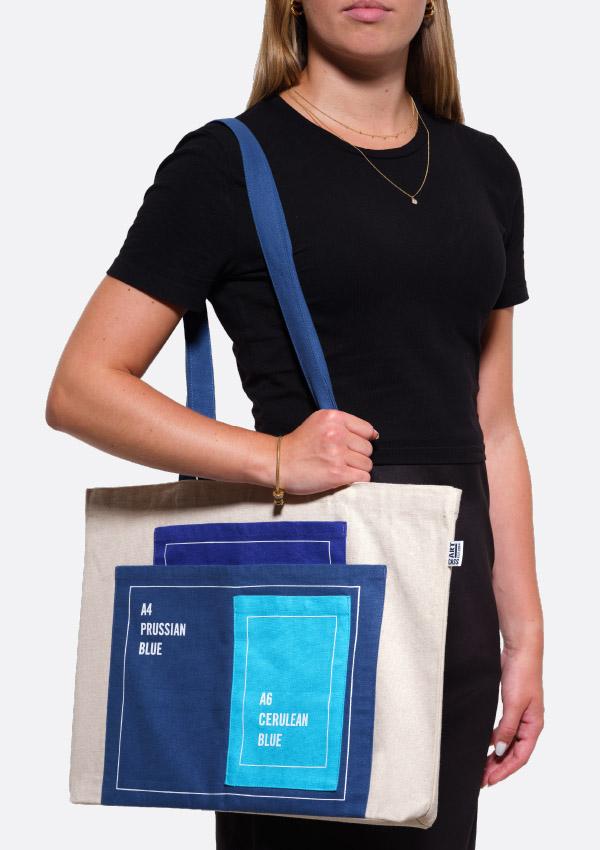
Cass Art special-edition bag featuring an A4 Prussian blue pocket, A5 French Ultramarine pocket, an A6 Cerelean Blue pocket, and a black A7 interior pocket.
More than just a Tote Bag
As the world very wisely turned its back on plastic bags, at first the reusable tote bag seemed to be the perfect solution. Proudly sporting a cool tote bag from your favourite independent gallery or bookshop made you feel like you were doing your bit to save the planet, but after a while the humble tote bag became something quite different.
Marketing departments saw an opportunity and soon the tote became part of every company’s list of merch, essentially the acceptable equivalent of the logo-emblazoned golf umbrella or mouse mat. A tote bag that languishes in the cupboard will have a carbon footprint that well exceeds that of any plastic bag, so it’s important to create something that’s attractive, practical and most of all, that people will actually use.
For Bags of Art & Design, Pentagram, Cass Art and Bags of Ethics have worked together to create a beautiful but practical bag that people will want to use over and over again. Designed by Angus Hyland and Jon Marshall at Pentagram, the bags were prototyped and manufactured by Bags of Ethics, and made using responsibly sourced cotton by its over 80% female workforce.
Making its debut at this year’s London Design Festival, the bag is joined by 12 other unique tote bag designs produced in small editions. The starting point is an A3 landscape bag, sized to fit a Cass Art drawing pad. The different bags have multiple pockets in A4, A5, A6 and A7 sizes, as well as bespoke-shaped pockets to fit artists’ materials such as brushes, lino rollers, paint tubes or drawing pens. Inspired by the walls in workshops that hold these tools, some of the bags feature screenprinted silhouettes.
Elegantly designed and carefully executed, the Bags of Art & Design are both beautiful and useful.
“It’s great to be able to recognize the last 20 years’ successful partnership between Cass Art & Pentagram, and to celebrate one of our truly iconic Cass Art products. Our totes have been loved and worn with pride for many years, and we’re excited to welcome these beautiful new editions to the range – expertly constructed by the wonderful Bags of Ethics team. We look forward to ‘filling this town with totes!’ and a huge thank you to all involved.”
MARK CASS, CEO AND FOUNDER
Bags of Art & Design, London Design Festival 2023

Quinacridone Magenta and 19 Other Colours
Going back in time (in fact almost 1 million bags ago), we conceived the first message-driven Cass Art bag as a means to extend the brand statement, ‘Let’s fill this town with artists’, in the form of a portable billboard.
This was followed by a black and white bag, with ‘art in a bag’ writ large on one side and on the reverse a pattern created from silhouettes of famous artworks and icons, (which were lifted directly from the frieze we designed for the shop interiors).
A few years later, having gotten a little bored of the original concept, Mark was talking about the idea of taking ownership of colour, especially in relation to the way the product was merchandised in store. It seemed like a missed opportunity not to bring colour into the bags, especially since the names of paints and pigments for artists are so wonderfully exotic, going back centuries before Dulux or Farrow & Ball.
Artists’ paint names are wonderful examples of both the technical and alchemical. We started to create a series of limited-edition bags, each one devoted to a single artist’s colour.
The front of these new bags featured the name of the pigment, and on the reverse (below some technical information and provenance) was a typographic wall devoted to the titles of paintings – both famous and obscure – that were interesting examples of the colour in use and an excellent way to deliver some bitesize art history.
We released several at a time to create a seasonal palette, and I got used to seeing them on a daily basis on the tube, around the streets of London, and occasionally on a faraway beach. Over the years, we’ve covered the spectrum times over, and for a while I was considering how we could extend the idea into a new format, and at the same time upgrade to a more sustainable material.
Here at this year‘s London Design Festival we are introducing the brand new, sustainable Cass Art bag, along with some other concept bags based around the idea of materials and media.
Angus Hyland

Size Matters
There aren’t many things that most of the world agrees on, but paper sizes would seem to be one of them. Ingrained in the memory of designers and artists everywhere, the ‘A’ series of paper measurements began life in 1922 as the German DIN paper standard. The system was gradually adopted by different countries, eventually becoming both an international standard (ISO 216) as well as the official United Nations document format in 1975.
It’s now used in almost all countries across the world, apart from the USA, Canada, Mexico, Peru, Colombia, and the Dominican Republic. Each ISO paper size is one half of the area of the next larger size in the series, and the paper sizes are all based on a single aspect ratio of the square root of 2 (or approximately 1:1.41421).
A0 is the largest size and has a total area of one metre, with A10 being the smallest and A4 the most ubiquitous. The B series has the same aspect ratio as the A series (but with different proportions) and the C series is used for envelopes.
While the A series is widely used by both designers and artists, the sizes of specialist art paper take their names from the watermarks that the papers were originally branded with when they were made by hand. While ISO is the epitome of German logic, the French system is much more poetic with names such as Écu, Coquille, Carré and Cavalier.

A-Series Bags featuring Acrylic gouache paintings by Angus Hyland

The Technical Drawing Bag, designed to store an artist pad, set square, ruler, straight line pen, 0.5 mm pencil and isograph technical drawing pen.
Material World
The idea for the Material Bags builds on the A Series Bags and adds practical pockets for six different types of art or design activities: watercolour painting, oil and acrylic painting, technical drawing, collage and decoupage, printmaking and pencil sketching.
The pockets are intended to be both functional enclosures as well as graphic expressions for each piece of equipment necessary for the art activities.
It was envisaged that each bag might function as a starter kit, ready stocked by Cass Art with the correct equipment or the relevant discipline. The bags can also serve as an expression of the identity of the artist owner with the pockets used for actual art equipment or anything else that fits in a pleasing way.
The process for the A Series Bags and Material Bags was the same, they were primarily developed through physical prototyping both at the Pentagram workshop and at Bags of Ethics’ factory.
Jon Marshall

LEFT: The Collage & Decoupage Bag, designed to store an artist pad, cutting board, scissors and blades.
RIGHT: The Printmaking Bag, designed to store an artist pad, lino roller, lino blocks, ink, A5 notebook and pencil.
The Watercolour Bag, designed to store an artist pad, A5 watercolour notebook, watercolour tin and paintbrushes. The bag straps have been designed to allow the bag to comfortably fold into an A4 size.
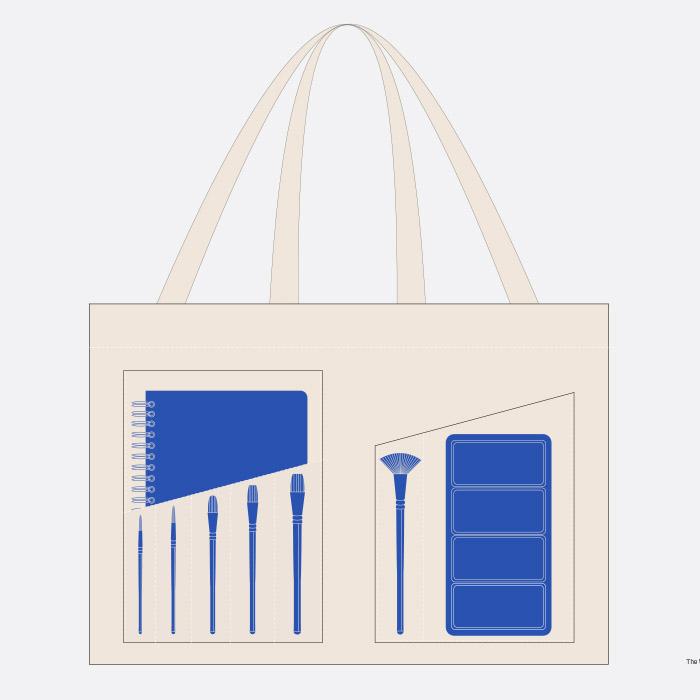
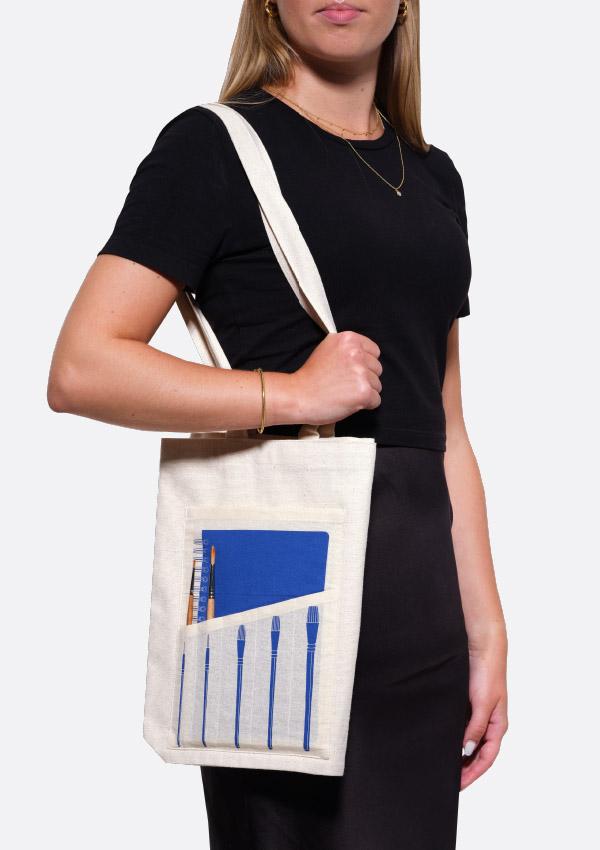

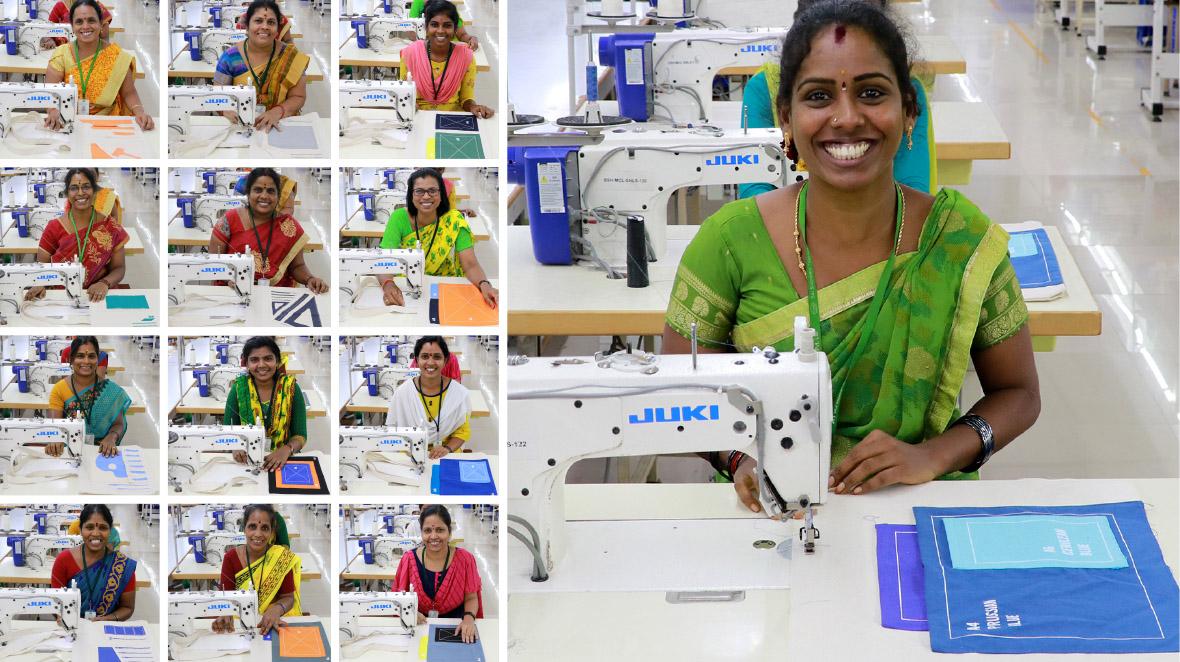
Meet the Makers
People and planet are at the heart of everything that Bags of Ethics do. Eighty per cent of its workforce are women, many in leadership roles.
The award-winning company prides itself on reducing waste wherever possible, be it from repurposing the waste water from printing into gardening water, or by upcycling fabrics to create trims and handles in the signature bags that the team makes. There are also thousands of trees and plants surrounding the factory, providing natural air cooling and a sense of wellbeing to the team.
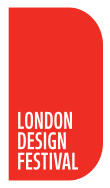
Bags of Art & Design
London Design Festival 2023, Wing Gallery, Second Floor, Cromwell Place, 4 Cromwell Place London SW7 2JE
16th–24th SEPT 2023
(THIS EVENT HAS NOW ENDED)

Established in London in 1972, Pentagram is one of the world’s leading multidisciplinary design studios with 22 partners working across offices in London, New York, Austin and Berlin. It has a unique partner-owned business model where every partner is a creative practitioner, runs their own team and works directly with their clients.

